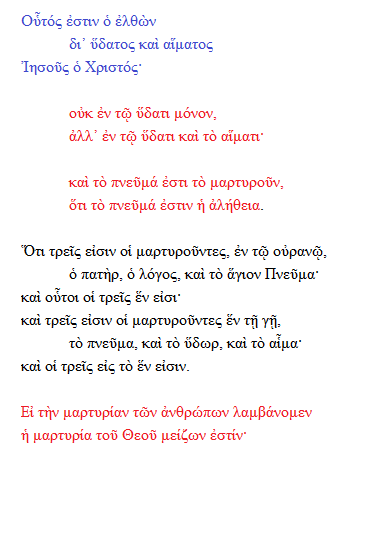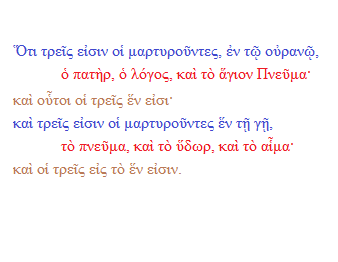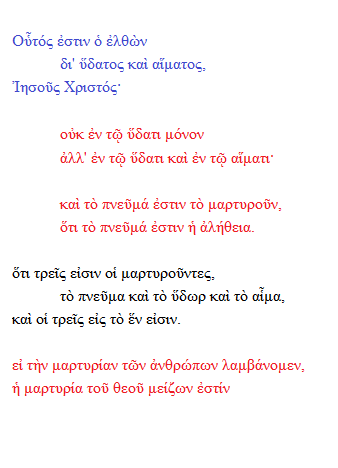Steven Avery
Administrator
Notes on the Internal Evidence in Favor of the Comma Johanneum (1 John 5:7–8)
Soverign Grace Blog
https://sovereigngraceblog.medium.c...-the-comma-johanneum-1-john-5-7-8-53e2ebaa149
Hebraic Parallelism in 1 John 5:6–9
One of the most striking, but totally forgotten, points of internal evidence for the Comma was first proposed by Rev. Charles Forster in his 1869 work A New Plea for the Authenticity of the Three Heavenly Witnesses. In his section on the internal evidence, he points out, building upon the work of Rev. Robert Lowth in his Lectures on the Sacred Poetry of the Hebrews, and Rev. John Jebb, who expounded further upon Lowth’s work in his Sacred Literature, that 1 John 5:6–9 in the Received Text is structured exactly according to the rules of Hebraic Parallelism, which is found all throughout the Old Testament, and carried over by the Biblical authors even into the Greek New Testament.

1 John 5:6–9a in the Greek Received Text
The passage, as it stands in the Received Text, is “a perfect example of Hebrew parallelism” and “strictly according to the laws of Hebrew poetry, as laid down by Bishops Lowth and Jebb” (Forster, pg. 237). It begins with an introductory clause (highlighted in blue), followed by two pairs of synonymous parallel couplets (highlighted in red), a six-line antithetical stanza (seen in black), and concludes with an antithetical parallel couplet. This fact is emphasized when we take notice of the coherence of the passage in light of each line within the six-line stanza having another corresponding line within the text — the first line corresponds to the fourth, the second with the fifth, and the third with the sixth.

The Antithetical Six-line Stanza in 1 John 5:7–8 in the Received Text
Forster comments (pg. 238):
The structure of this double sentence so knits together all its parts, as to shut out altogether the very idea of a break in its unity : St. Paul’s language alone can adequately describe its composition — the whole body fitly joined together, and compacted by that which every joint supplieth , according to the effectual working in the measure of every part.’
and:
To all readers acquainted with the rules of Hebrew parallelism it must at once be apparent, that a sentence so constructed authenticates itself; and speaks, at the same time, syntaxically for the authenticity of the text of the three Heavenly Witnesses.
As one can see by simply comparing the Received Text to that of the Critical Text, however, the structure of the passage becomes completely marred when the Comma is omitted.

1 John 5:6–9a from the NA26 Edition Greek NT
In the Critical Text, we now have an introductory clause, followed by two pairs of synonymous parallel couplets, followed by a three-line stanza which has no correspondent within the surrounding text, and then a concluding antithetical couplet — thus introducing an awkward three-line stanza into the midst of a block of surrounding Hebraic parallelisms. A very awkward, and “harder” reading indeed.
Soverign Grace Blog
https://sovereigngraceblog.medium.c...-the-comma-johanneum-1-john-5-7-8-53e2ebaa149
Hebraic Parallelism in 1 John 5:6–9
One of the most striking, but totally forgotten, points of internal evidence for the Comma was first proposed by Rev. Charles Forster in his 1869 work A New Plea for the Authenticity of the Three Heavenly Witnesses. In his section on the internal evidence, he points out, building upon the work of Rev. Robert Lowth in his Lectures on the Sacred Poetry of the Hebrews, and Rev. John Jebb, who expounded further upon Lowth’s work in his Sacred Literature, that 1 John 5:6–9 in the Received Text is structured exactly according to the rules of Hebraic Parallelism, which is found all throughout the Old Testament, and carried over by the Biblical authors even into the Greek New Testament.

1 John 5:6–9a in the Greek Received Text
The passage, as it stands in the Received Text, is “a perfect example of Hebrew parallelism” and “strictly according to the laws of Hebrew poetry, as laid down by Bishops Lowth and Jebb” (Forster, pg. 237). It begins with an introductory clause (highlighted in blue), followed by two pairs of synonymous parallel couplets (highlighted in red), a six-line antithetical stanza (seen in black), and concludes with an antithetical parallel couplet. This fact is emphasized when we take notice of the coherence of the passage in light of each line within the six-line stanza having another corresponding line within the text — the first line corresponds to the fourth, the second with the fifth, and the third with the sixth.

The Antithetical Six-line Stanza in 1 John 5:7–8 in the Received Text
Forster comments (pg. 238):
The structure of this double sentence so knits together all its parts, as to shut out altogether the very idea of a break in its unity : St. Paul’s language alone can adequately describe its composition — the whole body fitly joined together, and compacted by that which every joint supplieth , according to the effectual working in the measure of every part.’
and:
To all readers acquainted with the rules of Hebrew parallelism it must at once be apparent, that a sentence so constructed authenticates itself; and speaks, at the same time, syntaxically for the authenticity of the text of the three Heavenly Witnesses.
As one can see by simply comparing the Received Text to that of the Critical Text, however, the structure of the passage becomes completely marred when the Comma is omitted.

1 John 5:6–9a from the NA26 Edition Greek NT
In the Critical Text, we now have an introductory clause, followed by two pairs of synonymous parallel couplets, followed by a three-line stanza which has no correspondent within the surrounding text, and then a concluding antithetical couplet — thus introducing an awkward three-line stanza into the midst of a block of surrounding Hebraic parallelisms. A very awkward, and “harder” reading indeed.
Last edited:
